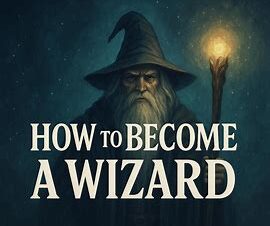“The History and Lineage of Wizards”
🎯 Learning Objectives
By the end of this section, you should be able to:
- Explain how the concept of the wizard evolved across different cultures and eras.
- Identify key figures in myth, history, and literature who shaped the wizard archetype.
- Differentiate between legendary wizards and historical wise ones.
- Understand how wizardry connects with philosophy, science, and spiritual traditions.
- Recognize the role of lineage and tradition in forming modern wizardry.
📜 Lecture Script
1. Why Study the History of Wizards?
To understand who we are as wizards today, we must know where we came from. Wizardry, though often cloaked in myth, has roots that stretch across cultures, religions, philosophies, and sciences. By exploring the stories of wizards past, we not only gain inspiration but also a sense of lineage: the idea that we are part of a tradition stretching back thousands of years.
History gives us a map. It shows how the archetype of the wizard evolved from tribal shamans to medieval scholars to modern seekers. It reminds us that wizardry is not new—it is ancient, reborn in every generation.
2. The Ancient Wise Ones
Before the word wizard was ever spoken, humanity had wise ones: those who carried knowledge of healing, the stars, plants, and rituals.
- Shamans in tribal societies acted as healers, dream interpreters, and keepers of sacred lore.
- Druids in Celtic cultures were philosophers, astronomers, judges, and priests. They preserved oral tradition and taught through memory and story.
- Magi in Persia were priest-philosophers known for studying the heavens and guiding kings (it is from “Magi” that we get “magic”).
- Philosophers in Greece such as Pythagoras and Plato were seekers of wisdom, exploring the mysteries of number, soul, and cosmos.
Though separated by geography, these wise ones shared a common role: they were mediators between the seen and the unseen, guides for their people, and keepers of knowledge.
3. The Archetype of the Wizard in Myth
Across legends, the wizard appears as a mentor, guide, or hidden master:
- Merlin in Arthurian legend, counselor to King Arthur, blending druidic and Christian imagery.
- Moses in Biblical tradition, leading his people with wisdom and miracles (Exodus 3–14, NASB).
- Thoth in Egyptian myth, god of wisdom, writing, and magic.
- Hermes Trismegistus in Greek-Egyptian lore, source of Hermetic philosophy.
- Odin in Norse mythology, a seeker of wisdom who sacrificed an eye for knowledge of the runes.
These stories reflect humanity’s longing for figures who could bridge heaven and earth, mystery and reason, symbol and reality.
4. The Medieval Wizards
As Europe entered the Middle Ages, wizardry took on new forms:
- Scholars studied alchemy, searching for transformation of matter and soul.
- Astrologers mapped the stars to understand fate and timing.
- Monks and mystics preserved ancient texts and experimented with natural philosophy.
Figures such as Roger Bacon (1219–1292), a Franciscan friar, combined science, alchemy, and theology, earning a reputation as a “wizard.” Others like Paracelsus (1493–1541) pushed medicine forward through experimentation, blending herbal lore with observation.
Here, wizardry began to merge with early science, paving the way for the modern world.
5. The Renaissance and the Scientific Revolution
During the Renaissance, the wizardly path flowered again through:
- Alchemy and Hermeticism (Marsilio Ficino, Giordano Bruno).
- Natural philosophy (Galileo, Newton, Kepler) which transformed into modern science.
- Magical systems such as the Kabbalah and astrology, which informed symbolic language.
Though some were persecuted, many wizards disguised their studies in art, literature, or secret societies. The Renaissance wizard was part scholar, part philosopher, part magician.
6. Wizards in Literature and Legend
The modern image of the wizard owes much to literature:
- Shakespeare’s Prospero (The Tempest), who combined learning with command of spirits.
- Goethe’s Faust, the scholar who bargains for knowledge and power.
- Tolkien’s Gandalf, a guide and protector whose wisdom outweighs his spells.
- Rowling’s Dumbledore, a mentor figure balancing power with compassion.
These fictional wizards shaped how the public imagines wizardry, but behind the stories lie truths about responsibility, wisdom, and service.
7. The Grey School of Wizardry and Modern Lineage
In 2004, Oberon Zell-Ravenheart founded the Grey School of Wizardry, offering structured education in the 12 “colors” of wizardry. Inspired by both history and fantasy, it provides a framework for wizardry as a secular, real-world study.
This Home Study course aligns with that model, carrying forward the tradition of wizards as educators, healers, philosophers, and seekers.
The Grey School emphasizes wizardry as a craft, a philosophy, and a lifestyle—not fantasy role-play. Its Indigo focus points students toward metaphysics, self-awareness, and deeper mysteries.
8. Why Lineage Matters
Lineage is not about claiming bloodlines from Merlin or secret societies. Instead, lineage means:
- Carrying wisdom forward.
- Honoring those who came before.
- Contributing to the chain of knowledge.
When you study wizardry, you become part of this lineage. Every journal entry, every practice, every insight adds to the living tradition. You are not just a student—you are a link in a chain stretching back to the first wise ones.
9. Reflection Exercise
Take your journal and reflect:
- Which figure from history or myth do you feel most drawn to—Merlin, Solomon, Thoth, or another?
- Why do you feel connected to them?
- How does their story inspire your path as a wizard?
Write at least one page. This is your first step in aligning yourself with the lineage of wisdom.
(continued in Part 3: The Tools of the Wizard — Journals, Symbols, and Sacred Objects)
📚 References
- Zell-Ravenheart, Oberon. Grimoire for the Apprentice Wizard. New Page Books, 2004.
- Buckland, Raymond. Signs, Symbols & Omens. Llewellyn Publications, 2003.
- Frances Yates. Giordano Bruno and the Hermetic Tradition. Routledge, 1964.
- NASB Bible. Exodus 3–14.
- Grey School of Wizardry. www.greyschool.net
